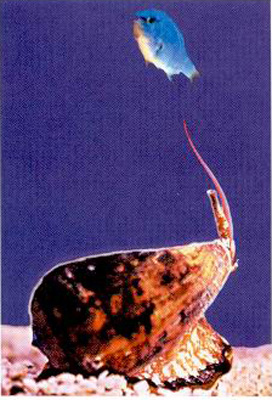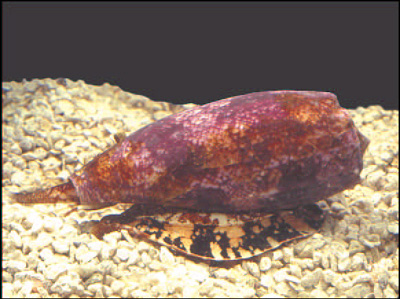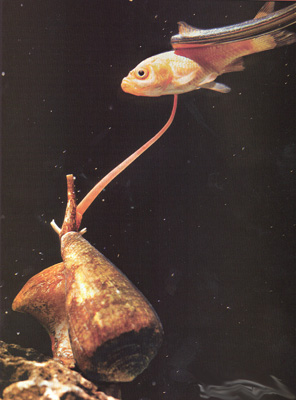Searching for “hallucinogen + conotoxin”, I found a book called Neuroscience , with too many authors to list here, published by Sinauer Associates of Sunderland, MA. Synchronistically enough, the book points out a connection between cone shell envenomation and betel nut intoxication! They both block the nicotinic ACh receptors. It all fits! Quoting from the book and lifting two of the illos:

“Another interesting class of animal toxins that selectively block nicotinic ACh and other receptors includes the peptides produced by fish-hunting marine cone snails (figure above). These colorful snails kill small fish by “shooting” venomous darts into them. The venom contains hundreds of peptides, known as the conotoxins, many of which target proteins that are important in synaptic transmission. … The array of physiological responses produced by these peptides all serve to immobilize any prey unfortunate enough to encounter the cone snail.”

“Another postsynaptic neurotoxin that, like nicotine, is used as a social drug is found in the seeds from the betel nut, Areca catechu (figure above). Betel nut chewing, although unknown in the United States, is practiced by up to 25% of the population in India, Bangladesh, Ceylon, Malaysia, and the Philippines. Chewing these nuts produces a euphoria caused by arecoline, an alkaloid agonist of nicotinic ACh receptors. Like nicotine, arecoline is an addictive central nervous system stimulant.”

Still more synchronicity. I quite smoking three weeks ago and still want a cigarette often. According to an interesting article on the poisonous geography cone shell,, [where I got the picture above] this Philipino mollusc is also known as the “cigarette snail” because if he stings you, you have enough time left to smoke a cigarette, and that’s it.

[Picture above from the Scientific American. You gotta love how long that geography cone shell can reach.]
Queen Mu of the old Mondo 2000 would love the idea of conotoxins; she used to like to go on about tarantula venom. How strong is the experience? Well, according to Gary Stix, “A Toxin Against Pain”, Scientific American, April, 2005,pp. 88-93, “In some cases, the side effects diminished. But not always. A patient’s delerium, in one instance, ended only after electroconvulsive therapy.”
Now that’s a bad trip, when it takes shock treatment to bring you down!
Question, if the neurotoxin blocks the nicotinic ACh receptors, does that mean that being hit with it is in some way like having a cigarette? Would it remove your desire to smoke?









April 12th, 2005 at 8:42 am
Keep riding your bicycle, Rudy. I quit smoking 10 months ago after 15 years of a pack-a-day habit, and I seem to have replaced my nicotine addiction with the benign endorphin addiction attendant to running.
I had to use the patch, incidentally; I’ve tried quitting cold-turkey, but for me, smoking was all about the dorsal monkey. But the important thing is that I haven’t had a significant craving in a long time. It does get easier, eventually.